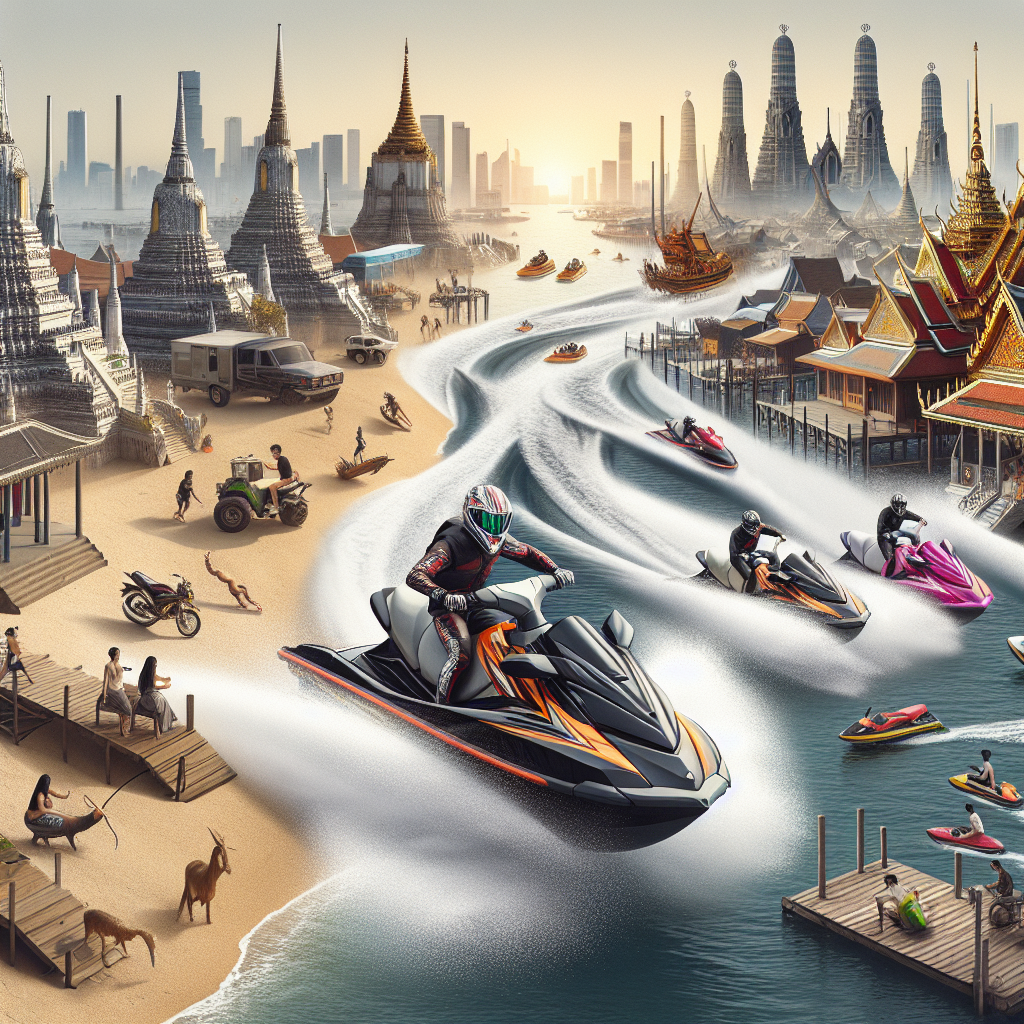Exploring the Rich History of Jet Skiing

If you’re a fan of adrenaline-pumping water sports, then you definitely need to know more about the rich history of jet skiing. From its humble beginnings to becoming a beloved recreational activity, jet skiing has come a long way. This exhilarating water sport combines the thrill of speed with the beauty of being out on the water. Whether you’re a seasoned jet skier or a beginner looking to try something new, learning about the history of jet skiing will deepen your appreciation for this exciting pastime. And if you’re in Orange Beach, AL and looking to rent a jet ski, make sure to check out A2Z Powersport located at the Fort Morgan Marina. These watersport experts will provide you with everything you need to have a memorable and safe jet skiing experience. So, let’s dive into the fascinating history of jet skiing and get ready for a thrilling ride!
History of Jet Skiing
Introduction
Jet skiing, also known as personal watercraft (PWC) riding, has become a popular watersport enjoyed by people around the world. It offers an exhilarating experience as individuals ride on the water, propelled by powerful jet engines. But how did this thrilling activity come to be? In this article, we will delve into the history of jet skiing, exploring its origins, development, and the impact it has had on popular culture.
Invention of the First Jet Ski
The story of jet skiing begins with Clayton Jacobson II, often hailed as the father of jet skiing. In the early 1970s, Jacobson, an Australian motocross enthusiast, sought to create a watercraft that could combine the thrill of riding a motorcycle with the freedom of being on the water. After years of experimentation and modifications, Jacobson developed the first jet ski prototype in 1973, marking the birth of this exciting watersport.
Evolution of Jet Ski Design
Since its invention, jet ski design has undergone significant transformations to enhance performance, safety, and user experience. Initially, the first jet ski model featured a sit-down design, resembling a small motorboat. However, as the sport gained popularity, the introduction of stand-up jet skis in the 1980s revolutionized the industry. Stand-up jet skis offered more agility and maneuverability, appealing to adrenaline-seeking riders.
Advancements in hull design played a crucial role in improving the jet ski riding experience. Manufacturers invested in developing hull shapes that optimized stability, control, and hydrodynamic efficiency. Alongside this, there were notable advances in engine technology, resulting in jet skis becoming more powerful and efficient. These developments allowed riders to experience even greater speeds and perform thrilling maneuvers on the water.
Innovation in seating arrangements also contributed to the evolution of jet ski design. Manufacturers introduced ergonomic seating and handlebar configurations that enhanced rider comfort and control. This made jet skiing accessible to a wider range of people, ensuring that riders could have an enjoyable experience regardless of their skill level.
Introduction of Personal Watercraft (PWC)
As jet skiing gained popularity, it led to the development of personal watercraft (PWC) – a broader category that encompasses various models beyond the traditional jet ski. PWCs provide a range of options, including sit-down jet skis, stand-up jet skis, and hybrid models that combine elements of both. This diversification allowed water enthusiasts to find the perfect PWC that suited their preferences and riding style.
Within the PWC industry, several key players emerged, each contributing to the development of innovative models. Manufacturers such as Kawasaki, Yamaha, and Sea-Doo have played significant roles in shaping the modern PWC market. Their continuous efforts to improve performance, safety features, and overall user experience have driven the advancement of jet ski technology.
Popularity and Growth of Jet Skiing
The 1980s marked a turning point for the jet skiing industry as recreational water activities gained popularity. Jet skiing rapidly emerged as a thrilling leisure pursuit that appealed to adventure-seekers worldwide. As more people discovered the thrill of riding on the water, the demand for jet skis grew exponentially.
The growth of tourism also played a pivotal role in the popularity of jet skiing. Coastal destinations around the world recognized the appeal of jet skiing as a tourism activity, leading to the establishment of rental businesses and waterfront resorts catering to jet ski enthusiasts. Today, countless tourists incorporate jet skiing into their vacation itineraries, further contributing to the industry’s expansion.
Jet skiing has also become a popular recreational activity for people of all ages, genders, and backgrounds. The jet skiing community encompasses a diverse range of individuals, creating a vibrant and welcoming atmosphere for riders to connect and share their passion. Demographics show that jet skiing appeals to both seasoned riders seeking adrenaline-pumping experiences and beginners looking for a fun and accessible watersport.
Racing and Competitive Jet Skiing
With the growth of jet skiing as a recreational activity, it was only a matter of time before competitive racing emerged. Jet ski racing has become a thrilling and exciting branch of the sport, attracting skilled riders who crave high-speed adrenaline rushes and intense battles on the water.
Different racing classes and formats cater to various skill levels and riding styles. From amateur races to professional competitions, the world of jet ski racing offers opportunities for riders of all backgrounds to engage in thrilling competitions. Races take place in various settings, including open water courses, closed circuits, and freestyle competitions that showcase daring aerial manoeuvers.
Famous races and competitions have earned their place in jet skiing history and serve as significant milestones in the sport’s development. Events like the IJSBA World Finals, the AquaX World Series, and the Pro Watercross Tour have brought together the best jet ski racers from around the globe, captivating audiences with their incredible skills and heart-pounding performances.
Jet Skiing in Popular Culture
Jet skiing has become an icon in popular culture, making appearances in movies, TV shows, music, and influencing trends beyond the watersport realm. Its portrayal in various forms of media has contributed to the consolidation of jet skiing as an exciting and adrenaline-inducing activity.
Movies and TV shows often feature jet skiing, depicting it as a thrilling and adventurous pursuit. From James Bond films to Baywatch, jet skiing has found its place in Hollywood, permeating the public’s consciousness as a symbol of excitement and freedom on the water. Additionally, music and lyrics have also embraced jet skiing, with numerous songs referencing the sport through catchy and energetic melodies.
Famous personalities within the jet skiing community have contributed to the sport’s visibility and popularity. Influencers, professional riders, and industry leaders have built careers around their passion for jet skiing, inspiring others to discover and engage with this thrilling watersport. These influential figures have played a significant role in shaping the culture and community surrounding jet skiing.
Environmental Concerns and Regulations
As with any activity involving natural resources, jet skiing has raised environmental concerns that cannot be overlooked. The impact of jet skiing on water ecosystems has been an ongoing point of discussion among environmentalists and policymakers. The powerful engines used in jet skis can contribute to water pollution and disturb aquatic wildlife, raising concerns about the preservation of delicate ecosystems.
Efforts to address these concerns have been made by both industry stakeholders and conservation organizations. Manufacturers have implemented technologies to reduce emissions and noise pollution, working towards more sustainable and environmentally-friendly jet ski models. Collaboration with conservation organizations has resulted in the development of best practices to mitigate environmental impacts, ensuring that jet skiers can enjoy the sport responsibly without compromising the ecosystems they navigate.
Regulatory measures and restrictions have been put in place in various jurisdictions to manage the environmental impact of jet skiing. These measures often include speed limits, noise restrictions, and designated areas where jet skiing is permitted. By adhering to these regulations, riders can help protect the natural habitats they explore while still enjoying the thrills of jet skiing.
Safety Measures for Jet Skiing
With any adventurous activity, safety is of paramount importance. Jet skiing is no exception, and various safety measures should be followed to ensure a enjoyable and risk-free experience. Before embarking on a jet ski adventure, riders should familiarize themselves with the correct operation of the PWC, including starting and stopping procedures, throttle control, and emergency shut-off features.
Wearing personal flotation devices (PFDs) is crucial for the safety of jet skiers. PFDs provide buoyancy and ensure that riders remain afloat in case of an accident or unexpected water entry. Additionally, riders should always be aware of their surroundings, keeping a safe distance from other watercraft and being mindful of potential hazards such as buoys, rocks, or other obstructions.
Knowledge of local rules and regulations is essential to ensuring a safe jet skiing experience. Familiarize yourself with the specific laws and requirements of the area where you are riding, including speed limits, age restrictions, and any licensing or certification requirements. By following these guidelines and maintaining situational awareness, riders can minimize risks and enjoy the thrills of jet skiing responsibly.
Future of Jet Skiing
As technology continues to evolve, the future of jet skiing holds exciting prospects. Technological advancements are contributing to the development of more efficient and sustainable jet ski models. One notable trend is the integration of electric propulsion systems, offering a greener alternative to traditional combustion engines. Electric jet skis could provide a quieter and emission-free riding experience, reducing the industry’s environmental footprint.
The incorporation of artificial intelligence (AI) and safety systems is another area of potential development. AI-powered features such as collision avoidance, auto-balancing, and emergency response systems could enhance rider safety and prevent accidents. Manufacturers are actively exploring these possibilities, aiming to provide riders with the highest level of safety and enjoyment.
Furthermore, the jet skiing industry is poised to witness continued growth and diversification. New models and variations of PWCs will cater to evolving consumer preferences and expand the range of options available for riders. The increasing popularity of jet skiing as a leisure pursuit and tourism activity will drive innovation, ensuring that the sport remains dynamic and appealing for years to come.
In conclusion, the history of jet skiing has seen an incredible journey from its invention to its prominent place in popular culture. Through continuous advancements, jet skiing has evolved into a thrilling watersport enjoyed by a diverse community worldwide. While environmental concerns and safety considerations remain important, the future of jet skiing holds promise and excitement, with technological advancements and innovative trends shaping the industry. Whether you are a seasoned rider or new to the sport, jet skiing offers a unique and unforgettable experience on the water. So, grab your PWC, follow the safety guidelines, and embark on an adventure that combines the freedom of the open water with the thrill of high-speed rides.










